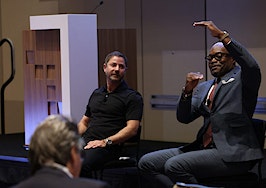Inman events are the best way to connect, learn and grow. Join us Oct. 26-28, for Inman Connect Las Vegas, in-person or virtually. Then, continue to gain insights, strategies and tactics to keep your business growing and make 2022 your best year ever with a full line-up of 2022 events! Save the dates and register now!
The popularity of real estate teams has exploded over the past several years, with talented real estate brokers seizing the opportunity to dominate a market with a team of dozens or hundreds of agents at their side.
Although the rewards are many, Keller Williams Preferred Properties Taylor Made Team leader Leisel L. Taylor and Engel & Völkers Jacksonville Beach broker-owner Corey Hasting reminded the Agent Connect crowd that starting a team requires many sacrifices that include placing your personal goals on the backburner to ensure the success of all.

Corey Hasting
“Everybody has the idea of what is it build or join a team, but there’s actually a lot of work that goes into it,” Hasting said. “What are you going to provide to them as a team leader, as far as the structure and everything else? Are you ready for that?”
“It takes away from your work-life balance and it takes away from your current business,” he added. “But if it’s done properly, it can be a magical thing. It’s a matter if you’re ready for it and having the structure for it.”
Hasting and Taylor said before starting a team, aspiring team leaders must be dedicated to the process, be clear about their “why” and determine their unique value proposition for agents.
“My husband and I actually thought about having a team before we were actually ready to have a team, and I think the first step of that process was having the mindset that even though we weren’t ready, we knew we wanted a team,” Taylor said. “Then the next step was creating a plan, hiring a coach and doing as much due diligence as [we] could.”
Taylor said the most important part of the planning process was finding a robust customer relationship management (CRM) platform and re-evaluating the lead generation process to make sure she had the tools, systems and leads to sustain a team.

Leisel Taylor
“One of the things for me was actually looking at a CRM because I wanted to make sure that our team, whether we had five agents or 500 agents, had a CRM that could support our business so we wouldn’t have to keep upgrading the CRM to fit the size of the team,” she said. “Another thing was looking at our resources and the type of leads that were coming in.”
“I was really intentional on tracking the number of leads that we were getting, whether they were buyer leads or seller leads, how many leads are converting, how many are actually signing, and from all of those signed agreements, how many were taken to closing?” she added. “I wanted to make sure we have enough business to support our agent partners because, at the end of the day, we all feel want to run a profitable business, right?”
In addition to ensuring you have the correct tools and systems in place, Hasting said aspiring team leaders need to have a clear understanding of what agents want and how they can provide it.
“People join teams in today’s market for a million different reasons,” he said. “It’s imperative for the team lead to offer value, which once again, means many different things for different people; it could be more work-life balance, having someone who can tell them what to do or lead generation. A really good team lead understands that what the team members need, which probably are never going to be the same thing.”
Hasting also said team leaders need to have a rigorous recruiting process that isn’t necessarily based on who they like, but who has the motivation and skills to take the team to the next level.
“When my advisors come to us or come to me and say ‘I want to join your team,’ my first question is ‘Why? Explain it to me,” he said. “We can all hang out after — no offense. We’re happy to work with our friends, but [our members] need to really create value.”
After getting your tools, systems and recruiting process in line, Taylor and Hasting said team leaders need to flexible enough to make adjustments in their business to help everyone meet their goals.
“There are so many different models out there, so there’s not a one size fits all box anymore,” Taylor explained. “The model that we created for our team, eight agents are producers and then two of them are administrators.”
“We tried the model where our agent partners were either buyers’ agents or listing agents, but we realized we weren’t having so much success with that,” she added. “We decided to let our agent partners let us know what they wanted to specialize in — if they wanted to be a buyer’s agent, if they wanted to be a listing agent, or if they wanted to do both.”
That flexibility, she said, has boosted her retention and enabled her agents to grow their individual businesses by leaps and bounds. “By giving our agent partners that choice, they were able to grow their business the way they desired,” she said. “We have an acronym that we use on our team: OPBWAE. It means ‘One plate, but we all eat.’ My husband and I are going to bring the plate (e.g. tools, systems, etc.), but we want everyone to eat off of it.”
Hasting said he extends that same flexibility to his team leaders on how they want to split commissions, which he said isn’t the one-size-fits-all process some may expect. “For the longest time, teams were at a 50/50 split to the team lead,” he said. “We give the entire team one percentage and really allow the team lead to dictate who makes what based on their production and based off how much influence they have in the transaction.”
“In our brokerage, we’re really big on if the team members are happy, and then the team lead is happy, which means the brokerage is typically happy,” he added.
Finally, Hasting and Taylor said the best team leaders are committed to their team day-in and day-out and can provide the accountability, training, coaching and wisdom to make sure agents succeed.
“I’m kind of like the treasure map, right? The team leader understands the process and how to do these different things,” Hasting said. “When a teammate comes to me and says, ‘Hey, I really want to get to that $50 million in production. How can I do that?’ We have to give them the guidance to take that next step.”













